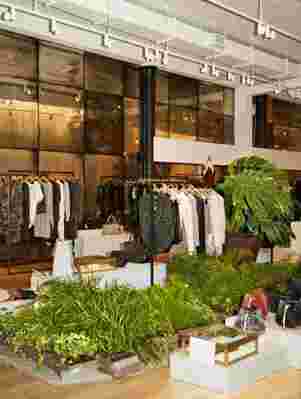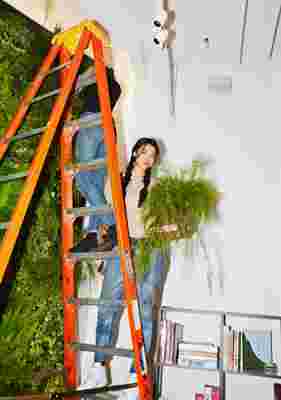Lily Kwong has held many seemingly dissonant job titles: model, podcast host, urban planner. Now she can also add designer for luxury brand Maiyet to her résumé. Kwong recently completed a stunningly verdant living wall for the sustainable fashion label, as well as a limited-edition botanical-inspired capsule collection, which will soon be available for purchase. For its first store in New York's NoHo neighborhood, Maiyet partnered with French architecture firm Ciguë to punctuate the space with blond oak floors, blackened steel hanging fixtures, golden leather seating, brass accents, and white plasterwork. The result is an organic harmony between these natural materials and the artisanal pieces the brand is known for. Kwong's green wall measures 7.5 feet by 12.6 feet and includes ten species of plants surrounded by freestanding foliage. We asked Kwong for her tips and tricks to create an equally stunning garden in your own home. Read on for her best advice.

Architectural Digest: What’s the secret to creating and maintaining a vertical garden?
Lily Kwong: My botanical mentor always says to me,"Right plant, right place." The success of any garden—vertical or not—is often determined in the planning phase. Observe your site. When is the light hitting it? How does the exposure change seasonally? Do your research and select plants that are going to thrive in the environment; tropicals and succulents are a good place to start.Also, be sure to water. Watering cycles vary with plant choices. Consult an expert and make sure your babies are getting fed!
AD: In what ways did the Maiyet store and brand influence your final product?
LK: I was really inspired by Maiyet's signature block-printed textile patterns, which are hand-chiseled by master craftspeople in India. These detailed blocks are inked and placed onto the fabric in a precise, interlocking pattern. This artisan technique is featured in the botanical-inspired capsule collection I designed with Maiyet. I fell in love with the texture and palpable touch of the prints. This beautiful process reminded me of how I develop a planting plan. Each species is prearranged, color coded, and then carefully installed to create a vibrant vertical landscape. Both art forms focus on layering textures and color.

AD: What types of plants are you using for Maiyet?
LK: The plants we're using have a great story behind them. This summer I designed a 150,000-square-foot jungle for an outdoor music venue called the Brooklyn Mirage. We installed seven truckloads of over 12,000 plants from South Florida in industrial Bushwick. I'm proud to say the company went to exhaustive lengths to develop an exit strategy for all the plants. Many rare species are being donated to the New York and Brooklyn botanical gardens, and all of the plants featured in Maiyet's landscape have been recycled from the Mirage project.

AD: What is the process like from start to finish?
LK: It depends. The Brooklyn Mirage's large-scale vertical gardens took a couple of weeks and a ton of manpower. The Maiyet project took a couple of days to install. My team starts by prepping the space: running irrigation, building a framework, waterproofing. Getting dirty is the fun part. We pre-plant the living wall system and then install the project in sections. The most exciting part is seeing how the green wall develops—it never, ever turns out exactly like the sketches.
AD: How do you incorporate the space you’re working with into your work?
LK: I spend so much time just hanging around a space before I start drawing. I look for view corridors, interesting transitions, and really survey how people interact with the environment. Gardens evolve—many of the gardens I plant will outlast me! That's why it's so important to really understand the whole ecosystem. You have to make sure you're contributing something meaningful and enduring to the space and the community you're working in.
AD: How can people re-create your incredible vertical gardens on a small scale in their own homes?
LK: I do this in my own home: Get some cheap wall shelves—even ones from Urban Outfitters or IKEA will do. Load the shelves with dripping vines. If you pack the shelves with big-leaf vines like philodendron, pothos, or tradescantia, the vegetation will fill out and hide the shelving system. Boom—you'll have the illusion of the green wall with none of the maintenance headaches!
